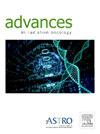盆腔放射治疗癌症患者循环炎症生物标志物水平与毒性的关联:一项重要综述
IF 2.7
Q3 ONCOLOGY
引用次数: 0
摘要
目的放射治疗(RT)引起组织损伤和炎症。由于细胞因子在这些过程中起着关键作用,它们的表达水平可以作为细胞和组织毒性的一个指标。这篇重要的综述旨在探讨外周血循环炎症生物标志物水平是否与盆腔区质子或光子治疗相关,以及这些水平如何随时间变化。此外,我们调查了这些水平是否与辐射剂量、毒性发生率以及毒性随时间的变化有关。方法和材料在PubMed上进行了文献检索,以查找涉及盆腔放疗癌症患者比较队列的研究。研究报告了外周血标志物与炎症过程和/或毒性的关联。结果:我们发现盆腔放射治疗癌症患者炎症细胞因子水平变化与总累积剂量-体积以及放射诱导毒性之间存在关联。常见患者报告的结果表明放射毒性(如生殖系统毒性)与循环炎症生物标志物水平之间存在关联。本综述强调,总累积剂量和辐照组织体积是rt诱导的生物标志物表达的主要驱动因素,影响早期和晚期毒性结果。不同研究中放疗技术、总剂量和治疗次数的差异可能导致观察结果的差异。血液中循环细胞因子和生物标志物水平可以为接受质子或光子骨盆放射治疗的患者提供有价值的监测和预测见解。在放疗背景下的生物标志物分析提供了临床价值,通过帮助预测哪些患者具有某些毒性的高风险,指导临床医生定制治疗,优化支持护理和调整放疗计划,从而实现个性化治疗。这种方法可以通过减少辐射暴露的长期并发症来改善患者的预后和生活质量。本文章由计算机程序翻译,如有差异,请以英文原文为准。
Association of Circulating Inflammatory Biomarker Levels and Toxicity in Patients Undergoing Pelvic Radiation for Cancer: A Critical Review
Purpose
Radiation therapy (RT) causes tissue damage and inflammation. Because cytokines play a key role in such processes, their expression levels can be an indicator of cell and tissue toxicity. This critical review aims to explore whether levels of circulating inflammatory biomarkers in peripheral blood are associated with proton- or photon-based therapy in the pelvic area and how these levels vary over time. Further, we investigated whether these levels can be linked to radiation dose, the incidence of toxicity, and changes in toxicity over time.
Methods and Materials
A literature search was conducted in PubMed to find studies involving comparative cohorts of pelvic irradiated patients with cancer. Studies reporting on the association of markers in peripheral blood with inflammatory processes and/or toxicity were included.
Results
We found evidence of associations between changes in inflammatory cytokine levels and the total cumulative dose-volume together with RT-induced toxicity in patients with cancer treated with pelvic RT. Common patient-reported outcomes demonstrate an association between radiation toxicity (eg, genitourinary toxicity) and circulating inflammatory biomarker levels.
Conclusions
This review highlights that the total cumulative dose and irradiated tissue volume are the primary drivers of RT-induced biomarker expression, influencing both early and late toxicity outcomes. The diversity in RT techniques, total dose, and number of treatment sessions across studies likely contributes to the variation in observed results. Circulating cytokine and biomarker levels in the blood can provide valuable monitoring and predictive insights for patients undergoing proton- or photon-based RT of the pelvis. Biomarker analysis in the context of RT offers clinical value by enabling personalized treatment by helping predict which patients are at higher risk for certain toxicities, guiding clinicians in tailoring treatment, optimizing supportive care, and adjusting RT plans. This approach could improve patient outcomes and quality of life by reducing long-term complications from radiation exposure.
求助全文
通过发布文献求助,成功后即可免费获取论文全文。
去求助
来源期刊

Advances in Radiation Oncology
Medicine-Radiology, Nuclear Medicine and Imaging
CiteScore
4.60
自引率
4.30%
发文量
208
审稿时长
98 days
期刊介绍:
The purpose of Advances is to provide information for clinicians who use radiation therapy by publishing: Clinical trial reports and reanalyses. Basic science original reports. Manuscripts examining health services research, comparative and cost effectiveness research, and systematic reviews. Case reports documenting unusual problems and solutions. High quality multi and single institutional series, as well as other novel retrospective hypothesis generating series. Timely critical reviews on important topics in radiation oncology, such as side effects. Articles reporting the natural history of disease and patterns of failure, particularly as they relate to treatment volume delineation. Articles on safety and quality in radiation therapy. Essays on clinical experience. Articles on practice transformation in radiation oncology, in particular: Aspects of health policy that may impact the future practice of radiation oncology. How information technology, such as data analytics and systems innovations, will change radiation oncology practice. Articles on imaging as they relate to radiation therapy treatment.
 求助内容:
求助内容: 应助结果提醒方式:
应助结果提醒方式:


